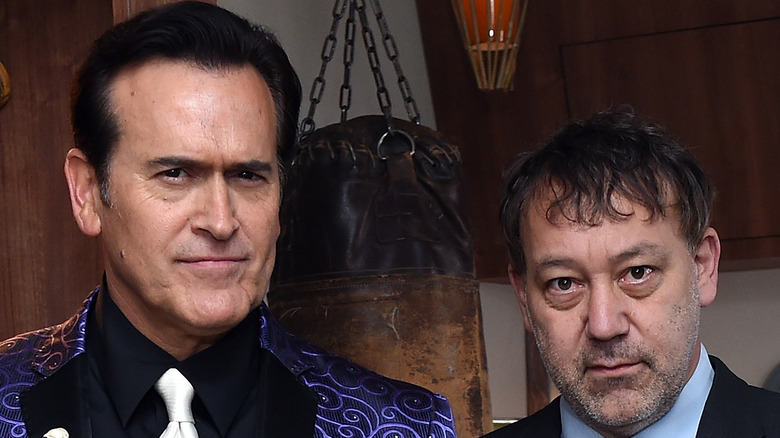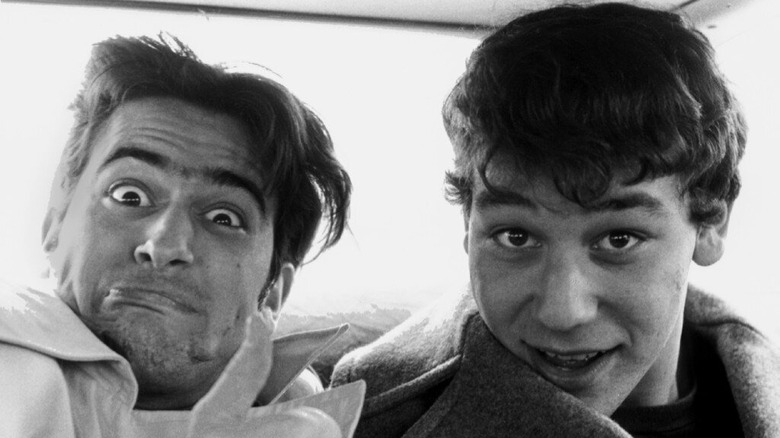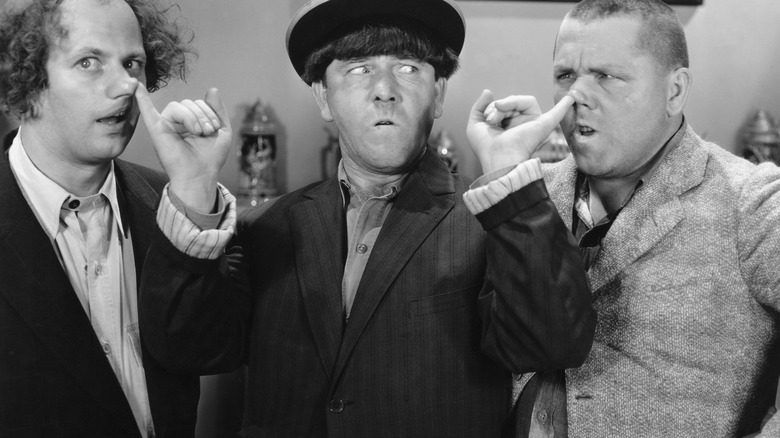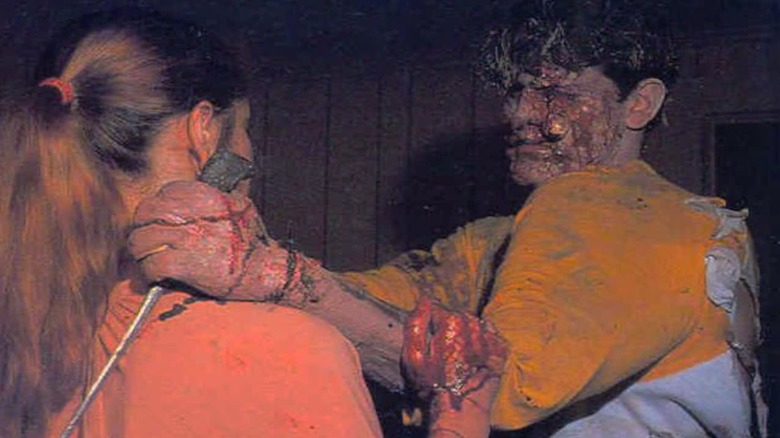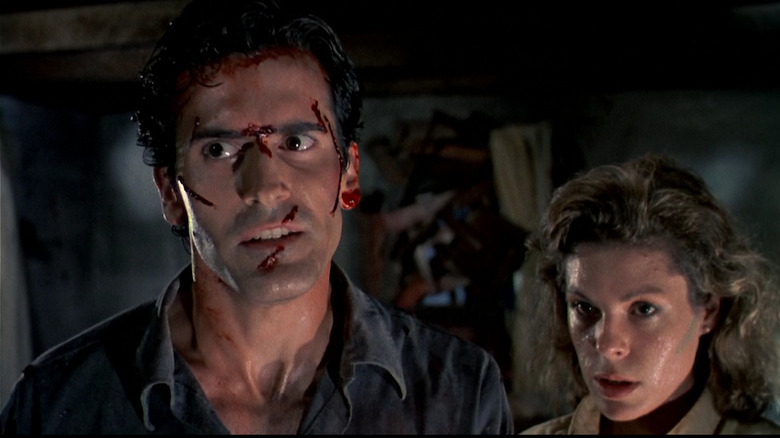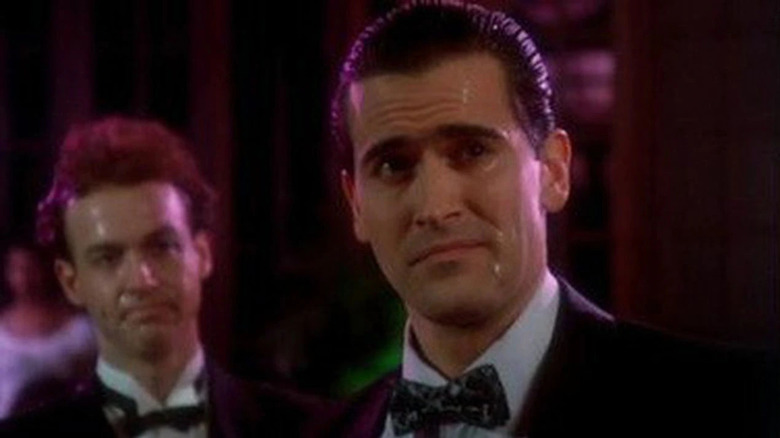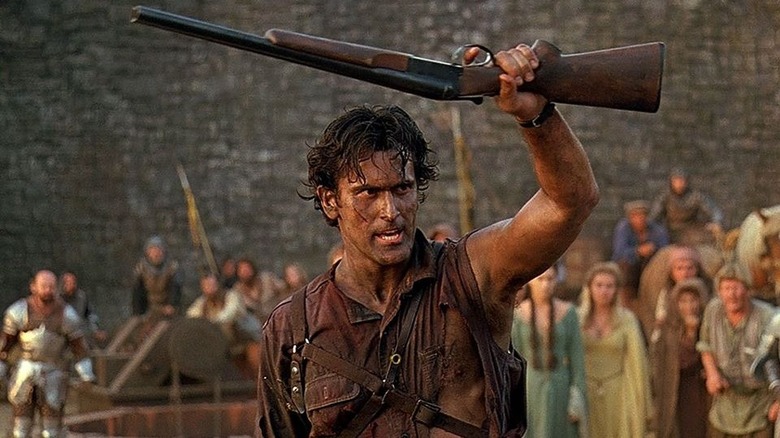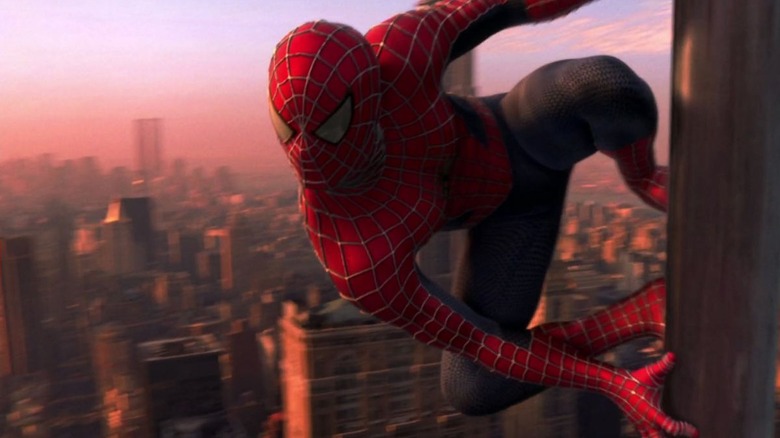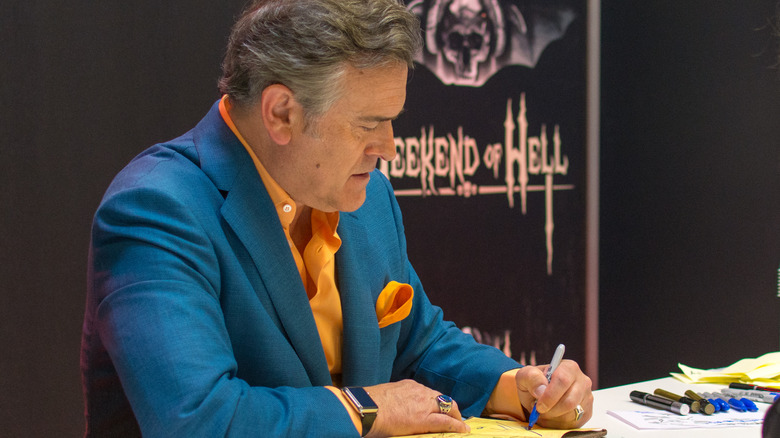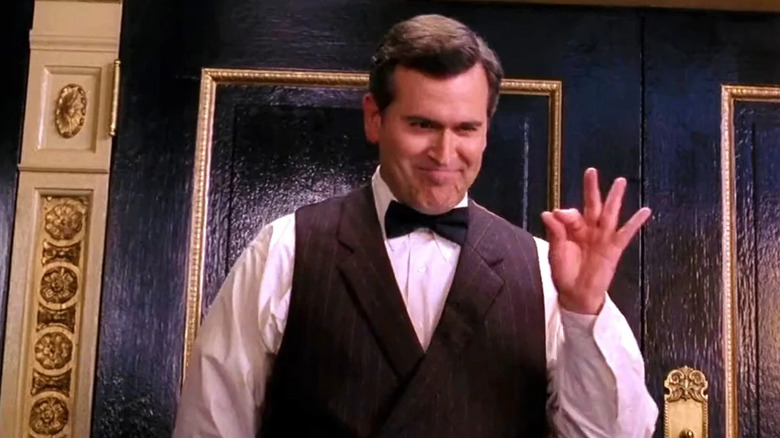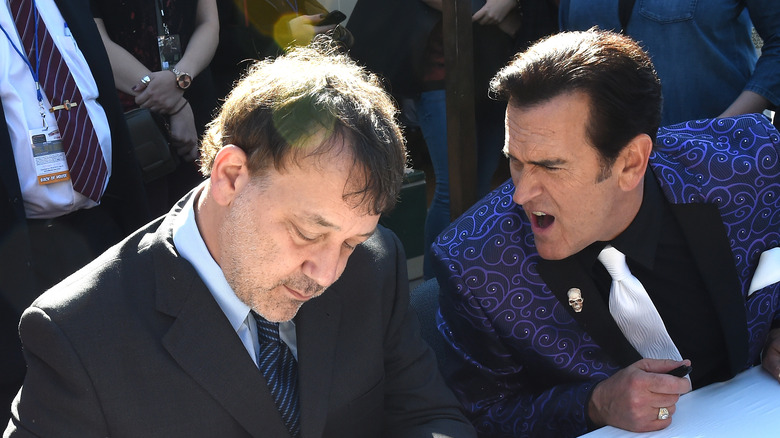Inside Sam Raimi's Friendship With Bruce Campbell
In an industry in which job security is short-lived and relationships are even more fleeting, Sam Raimi and Bruce Campbell's personal and professional partnership has been going strong for about half a century. Most kids who dream of making movies never get the chance, but Raimi and Campbell practically willed each other into careers in show business. They've remained close ever since, through every success, failure, and lesson learned in between.
Though Raimi admits he finds pleasure in torturing Campbell, the two clearly have each other's backs in the hyper-competitive and sometimes cruel world of Hollywood filmmaking. That they found and supported each other early worked out great not just for Raimi and Campbell, but for audiences; their frequent collaborations have produced some of the most innovative and influential movies and movie-making techniques, especially in the genre space, of the last 40+ years. Fans of one are almost always fans of the other in equal measure. They're like the chocolate and peanut butter of horror comedy; two great (and a little strange, gory, and over-the-top) tastes that go great together. This is how Sam Raimi and Bruce Campbell became filmmakers and lifelong friends.
They grew up in the same town and met at school
Sam Raimi and Bruce Campbell were both born in Royal Oak, Michigan just north of Detroit. Raimi, as he recalled to The Independent, was the fourth of the five children of parents who owned a furniture store and a lingerie boutique. His family initially encouraged his interest in film. His father even bought him his first Super 8 camera. Campbell recalled to Fatherly that his father, Charles, had wanted to be an artist, but his own grandfather forbade it and pushed him into a career in marketing. Only later in life did Charles get the chance to work in theater, so when his young son, Bruce, expressed a desire to perform, Charles not only allowed it but directed him and invested in his projects.
Campbell has described his own childhood as "damn near idyllic" to IGN, but Raimi's was marred by tragedy. His older brother Sander — from whom he'd learned how to perform magic — drowned in a swimming pool when he was only 15 and Sam was only 10. A story similar to that of Sander's death is told by Stephen Strange in "Doctor Strange in the Multiverse of Madness."
In an interview with Maximum Fun, Campbell explains how he and Raimi met during their eighth grade year at West Maple Middle School in the Wylie E. Groves School District. Campbell remembers Raimi being a weird kid and a promising artist who sometimes dressed like Sherlock Holmes and had a particularly astute sense for physical humor (including harming his friends for the sake of comedy), even early on. Raimi and Campbell also befriended another aspiring young filmmaker named Scott Spiegel around the time Raimi acquired that camera in his 13th year. Campbell and Spiegel later worked together at a grocery store.
They bonded over their love of pop culture, especially comedy
Today, Raimi and Campbell are most closely associated with genre films, especially horror and superhero movies. They did, tellingly, bond over horror flicks and Marvel comics too, but they began as aficionados of comedy. Both Raimi and Campbell were huge fans of "The Three Stooges," so when they began fooling around with film themselves in high school, they tended toward broad Stooge-style physical comedies.
Raimi had the camera, Spiegel had a home studio set up, and Campbell could borrow costumes from his and his father's theater company. The final ingredient for their teenage brand of slapstick cinema came from the grocery store where Campbell and Spiegel had afterschool jobs. The grocer would throw away old food — including pies — at the end of each day, so the resourceful filmmakers would use the expired pies to throw in each other's faces, for gags that they'd record. They called the resulting film "Pies and Guys."
Throughout their high school years, this crew of three spent nearly all of their free time producing Super 8 movies, including one lost to a malfunctioning projector that Raimi directed titled "The Great Bogus Pignut Swindle." During this time, they were only making movies to entertain themselves and their friends (and impress girls), but once graduation approached, they knew they'd have to get serious if they wanted to continue to spend time in front of and behind the camera.
Raimi cast Campbell in his short film
Upon their graduation, Raimi and Campbell went their separate ways ... for a little while at least. Raimi studied English at Michigan State University, and Campbell enrolled in Western Michigan University. He also joined a professional theater company and took jobs as a production assistant for local commercials, where he got an on-the-job education in filmmaking. However, college didn't agree with Raimi or Campbell, and both left to pursue filmmaking full time — a decision which Raimi's family couldn't support.
With the help of a friend from Michigan State named Rob Tapert (who would go on to co-create "Xena: Warrior Princess" and marry Lucy Lawless), the 19-year-olds raised $1,600 to make a 30 minute live-action short called "Within the Woods." Raimi would direct the film, based on his own short story. Campbell and Spiegel would star. They switched from comedy to horror because scary movies had been doing well at drive-ins, and they were cheap to make as they were contemporary and typically took place in a single location. Many of the film's effects had to be improvised on the spot, due to the extremely low budget. Campbell even slept in his makeup to save time and money.
Raimi used "Within the Woods" as a proof of concept film with which to attract potential investors for a planned full length feature. The short contains many of the plot points, themes, and visual styles for which he'd eventually become well known. They were able to get a local theater to play it before a screening of "The Rocky Horror Picture Show," but it's never been theatrically released. It did, however, allow Raimi to raise the $350,000 necessary to produce the movie that would propel him and Campbell to faster-than-expected fame.
The Evil Dead became a hit (with Stephen King's help)
Raimi — with Campbell as his star and producer — headed to a remote and supposedly haunted cabin in Tennessee to begin work on his debut feature. The cast and crew lived at the site during filming. It's here that Raimi came up with his motto, "the gore the merrier," as the movie they were making relied upon copious amounts of fake blood and latex. Raimi also pioneered his signature creative camera techniques, nailing his rented Kodak to pieces of wood to capture scenes from unexpected angles in intense-feeling ways.
Once filming was complete, Raimi and Campbell returned to the Detroit area for post-production and learned that, curiously, the cabin they'd used as a location was struck by lightning and burned down. A young Joel Coen helped with the editing, then it was time to find distribution. For that, they relied on Irvin Shapiro, a sales agent who'd worked with George Romero and was involved with the Cannes Film Festival. He helped them secure a bid from the UK's Palace Pictures. Campbell recalled to Game Informer that he and Raimi wanted to call the movie "The Book of the Dead" — a reference to the Necronomicon — but Shapiro convinced them that "The Evil Dead" would play better with audiences.
"The Evil Dead" played out of competition at Cannes in 1982, and one Stephen King happened to be in the audience. The acclaimed horror author became a vocal supporter of the movie, calling it "the most ferociously original film of the year," after which point "The Evil Dead" began to develop its massive cult following.
A new generation moves to Hollywood ... and struggles
Raimi and Campbell had gotten to know Joel and Ethan Coen during the making of "The Evil Dead." The writing and directing team of brothers were so inspired by Raimi and Campbell's gumption in making their film happen, they employed the same techniques to produce and sell their feature, "Blood Simple." Now that all four had experienced success, this group of friends from Michigan decided it was time to move west and try their luck in Hollywood.
In what might have been the most brimming-with-talent apartment in history, Raimi, Campbell, Spiegel, the Coens, as well as Joel's wife, Frances McDormand, Holly Hunter, and Kathy Bates all shacked up in the same rental, at least for awhile. During this time, some of the roommates collaborated on Raimi's next picture, "Crimewave," which the Coen brothers wrote. Campbell acted in the film, but he wasn't the lead.
"Crimewave" turned out to be one of the most fraught productions in Hollywood history. A still inexperienced Raimi struggled to manage the safety of his personnel on a tight budget. He and Campbell frequently clashed with producers and weren't happy with the final cut. The movie received largely negative reviews and flopped at the box office. However, everyone involved felt that they had at least learned from the movie's failures.
The Evil Dead turns into a franchise
After "Crimewave," Raimi fretted about what his next project would be, and Campbel career had stalled after "The Evil Dead." But Irvin Shapiro and Stephen King both pressed them to do a sequel to their indie hit and introduced them to producer Dino De Laurentiis. About a half hour later, they had a deal to make "Evil Dead 2."
Raimi and Campbell had an idea for a movie in which Ash would time travel to the Middle Ages. De Laurentiis, who was fronting them much more money than their previous budget, wanted something that was more like a soft reboot of the original with higher production values than a true part two. "Evil Dead 2" — which was significantly funnier than the first one — made its way to theaters in 1987 and was another big hit with critics and audiences.
The old friends would team up again to make the version of a sequel they'd wanted to make with 1992's "Army of Darkness," in which Ash accidentally time travels back to Medieval England, is deemed their Chosen One, and defends the kingdom from Deadites. To date, "The Evil Dead" has spawned four movies (with a fifth on the way), plus a TV series and a stage musical, as well as several comic books and video games. The franchise has large fan base that's particularly devoted to Bruce Campbell.
After his indie start, Raimi becomes a studio director
Though they still collaborated off and on, Raimi and Campbell (as well as the Coens) began to forge their own paths in the 90s. Raimi directed 1990's "Darkman" — his first foray into the superhero space — followed by the 1995 Western "The Quick and the Dead." After that, he made 1998's "A Simple Plan," a neo-noir thriller that could easily be mistaken for a Coen brothers film, then the 1999 Kevin Costner baseball drama, "For Love of the Game." All four of these films received okay-to-good reviews and performed well-enough at the box office, but they helped to establish Raimi as a reliable studio director.
That same year, as recounted in Variety's oral history of the first "Spider-Man" movie, Raimi's agent got him a meeting with Sony executives who were looking to make a Spider-Man movie. Raimi wasn't their first choice, but he impressed the room with his genuine understanding of and affection for the character. He got the job, and it's not much of a stretch to say that, as the old millennium became the new millennium, Sam Raimi changed the future of movies. His Tobey Maguire-led "Spider-Man," which premiered in 2002, made $825 million dollars and ushered in an era of earnest but fun superhero storytelling, without which the MCU probably wouldn't exist.
Raimi stayed on for the much-loved "Spider-Man 2" and the not-so-loved "Spider-Man 3" before returning to horror with 2009's "Drag Me to Hell." But, after 2013's critical and commercial disappointment, "Oz the Great and Powerful," this once prolific workman took an extended break (at least from making feature length films) until 2022's "Doctor Strange in the Multiverse of Madness."
Campbell's career goes in a different direction
Bruce Campbell continued to act in movies and TV, as well as voice characters in animation and for video games (he has over 150 credits to his name). He never quite reached his friend Raimi's A-list status, but he's done more in his five decade career than most wannabe or working artists could scarcely dream about. Campbell has appeared in soap operas as well as series like "Burn Notice." He's had smaller roles in big films like "Congo" and "The Majestic," and bigger roles in small films like "Bubba Ho-Tep." He's also written, directed, produced, and starred in some of his own movies like "My Name Is Bruce."
In between film and TV projects, Campbell has authored three books: "If Chins Could Kill: Confessions of a B Movie Actor," "Hail to the Chin: Further Confessions of a B Movie Actor," "The Cool Side of My Pillow," and "Make Love the Bruce Campbell Way." More recently, he's gotten into writing comics.
But besides his iconic role as Ash Williams and that distinctive chin, Campbell is known for being one of the most frank and accessible Hollywood personalities. In interviews, he's an open book. He's even more notorious for his embrace of fan conventions. He regularly attends such events, where he signs autographs, takes pictures, and participates in panel discussions and question and answer sessions. There's even a BruceFest in Detroit, Michigan.
Most Raimi movies contain a Campbell cameo
Though Bruce Campbell hasn't headlined a Sam Raimi movie in awhile, he's still been in many of them. Usually, Raimi puts Campbell in a cameo role, with his identity somewhat (but not very obviously) obscured, so that audiences can look for him in the same way that they looked for Stan Lee in Marvel movies.
In "Darkman," his face appears in the crowd in the last scene of the movie. He was also in a shot in "The Quick and the Dead," but the scene never made it into the film. Campbell plays three different characters in Raimi's "Spider-Man" trilogy. In the first one, he's the fight announcer who gives Peter Parker his superhero name. In the sequel, he's an usher who gets in Peter's way, and in the third film, he's the French maître d' at the restaurant where Peter intends to propose. Campbell's the gatekeeper in "Oz the Great and Powerful," and Pizza Poppa in "Doctor Strange in the Multiverse of Madness," where his post-credits stinger scene is arguably Marvel Studios' best troll of its audience to date.
Raimi told Rolling Stone that one reason he regretted the cancelation of his planned fourth "Spider-Man" project was that he had designed a "really great cameo" for Campbell. There were rumors that he wanted Campbell to play Mysterio, who eventually became the villain of "Spider-Man: Far From Home." Raimi admitted that this was one idea they'd batted around, but there were other possibilities.
They've remained friends through it all
Raimi and Campbell like to joke about the antagonistic nature of their more than 45 year friendship. "I find it to be a very healthy, productive, one-with-the universe-type thing to torment Bruce. And people love to watch his tormentation," Raimi told Entertainment Weekly as to why he so often puts his friend in harms way in his movies. For example, in "Doctor Strange in the Multiverse of Madness," Raimi has Strange curse his character, Pizza Poppa, into punching himself in the face for three weeks straight. But really, this is a half-sick, half-sweet commentary on the strength of their personal and professional relationship. Raimi clearly appreciates that Campbell's been with him, in body and spirit, since the beginning.
In "If Chins Could Kill," Campbell recounts the many times he's been scared or injured working with Raimi. The cast and crew got lost during their first day of shooting for "The Evil Dead" and suffered through miserable inclement weather. He's been seriously wounded doing his own stunts for Raimi at least twice. Before Raimi could command the kind of budgets that would make production safer and more comfortable (not to mention, totally legal), Campbell was not only willing to put his own body and money on the line, he stayed by Raimi's side for long hours to make sure things got done.
Though they no longer live in the same place (Raimi's family resides in California, Campbell's is in Oregon) or work exclusively on the same projects, they've stayed in each other's lives and visit each other's sets. There's no doubt, the friendship that started back in Michigan in 1975 will continue to play an important role in pop culture for years to come.
